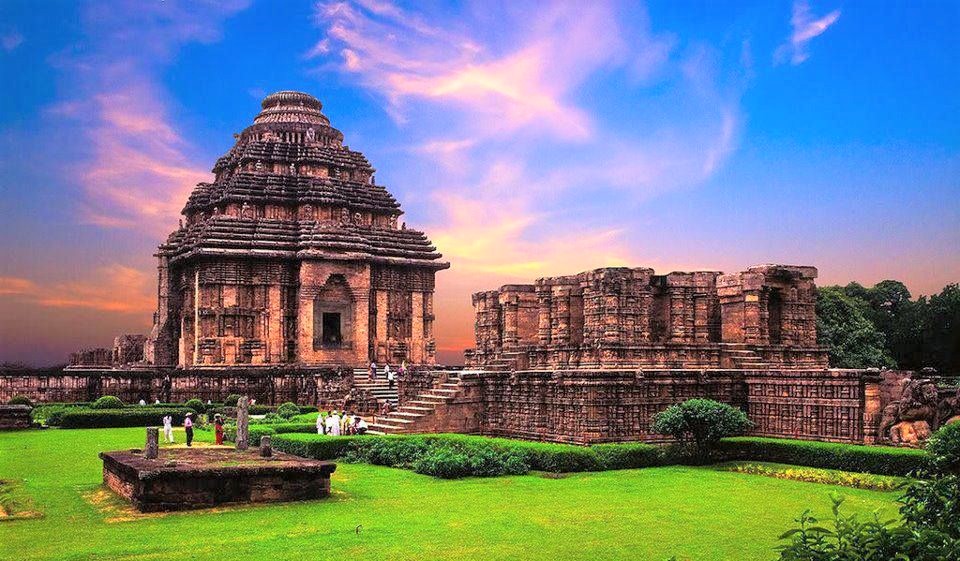The Sun Temple, also known as the Konark Temple, is a 13th-century Hindu temple located in the eastern Indian state of Odisha. The temple is dedicated to Surya, the Hindu sun god, and is considered one of the finest examples of Kalinga architecture, a style of architecture that originated in ancient Odisha.The Sun Temple was built by King Narasimhadeva I of the Eastern Ganga Dynasty in the 13th century. The temple was designed to resemble a giant chariot, with 24 intricately carved stone wheels and seven horses, and is considered a masterpiece of ancient Indian architecture.The temple was designed as a giant astronomical instrument, with each of its wheels serving as a sundial, and the temple's structure casting shadows that mark the time of day. The temple also features intricate carvings and sculptures that depict scenes from Hindu mythology, as well as images of animals, musicians, dancers, and celestial beings.Over the centuries, the Sun Temple fell into disrepair and was partially destroyed by natural disasters and invasions. However, significant restoration work has been carried out in recent years, with the Indian government and UNESCO working together to preserve and protect this important cultural heritage site.In recognition of its historical and cultural significance, the Sun Temple was designated a UNESCO World Heritage Site in 1984. Today, the temple remains an important religious site and a popular tourist destination, attracting visitors from around the world who come to marvel at its beauty and learn about its rich cultural history.The Sun Temple at Konark is widely regarded as one of the greatest masterpieces of Indian architecture, and its intricate carvings and sculptures are considered among the finest examples of ancient Indian art. The temple complex consists of the main temple, which is surrounded by smaller shrines and pavilions, as well as a large open-air theatre that was used for performances and ceremonies.The temple's impressive size and intricate design are a testament to the skill and ingenuity of the ancient Indian architects and craftsmen who built it. The temple's walls are covered with intricate carvings that depict a wide range of subjects, including scenes from Hindu mythology, animals, musicians, dancers, and celestial beings.The temple was designed to serve as a giant astronomical instrument, with each of its 24 wheels serving as a sundial that marked the time of day. The temple was also designed to align with the movement of the sun, and its structure casts shadows that indicate the time of day with remarkable accuracy.Despite its status as a UNESCO World Heritage Site, the Sun Temple faces numerous threats to its preservation and conservation. Natural disasters such as floods and earthquakes have caused significant damage to the temple over the centuries, and human activities such as tourism and nearby construction also pose a threat to the temple's structural integrity.Efforts are currently underway to preserve and protect the temple, including ongoing restoration and conservation work, as well as initiatives to promote sustainable tourism practices that minimize the impact of tourism on the temple and its surrounding environment. The Indian government and UNESCO have also established a number of programs and initiatives aimed at raising awareness about the temple's historical and cultural significance and promoting its preservation and conservation for future generations.In addition to its architectural and artistic significance, the Sun Temple at Konark also played an important role in the religious and cultural life of the people of ancient Odisha. The temple was a major center of sun worship, and was considered a sacred site where devotees could offer prayers and seek blessings from the sun god.The temple complex was also a center of cultural activity, and was home to a large community of scholars, poets, musicians, and artists who contributed to the development of Odishan culture and literature. The temple's open-air theatre, in particular, was a major cultural venue where musicians, dancers, and performers would gather to entertain the crowds.Over the centuries, the Sun Temple at Konark has faced numerous challenges and threats, from natural disasters and invasions to neglect and decay. However, its enduring legacy as a masterpiece of Indian architecture and art, as well as its importance as a symbol of Odishan culture and history, have ensured that it remains a beloved and revered cultural heritage site to this day.Through ongoing preservation and conservation efforts, as well as initiatives aimed at promoting sustainable tourism and raising awareness about the temple's historical and cultural significance, the Sun Temple at Konark is poised to continue inspiring awe and wonder in visitors from around the world for generations to come.




0 Comments